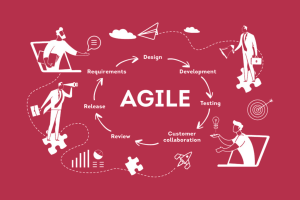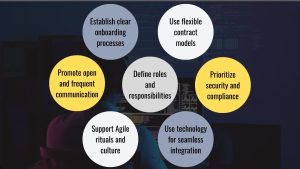content
Team Augmentation
February 24, 2025
6 min read
Introduction
In today’s fast-paced digital world, companies need to stay agile. Agile methodologies help teams adapt to change and deliver value quickly. However, scaling Agile with external expertise can be challenging. How can you ensure seamless collaboration between internal and augmented teams? How can you maintain efficiency and agility?
Agile augmentation is the answer. It combines the benefits of Agile workflows with the flexibility of external expertise. Let’s look at how to effectively integrate augmented teams while maintaining high productivity and collaboration.
Why Businesses Turn to Agile Augmentation
Companies are facing increasing demands for faster development and high-quality products. However, hiring full-time employees for every project is not always practical. Augmenting teams with external experts allows companies to scale as needed. This approach helps fill skill gaps, speed up development, and reduce costs.
What’s more, Agile thrives on collaboration, making it a natural fit for team expansion. When done right, augmented team members can participate in sprints, standups, and retrospectives just like full-time employees.

Challenges of Integrating Augmented Teams
Bringing in external talent isn’t always a smooth process. Without the right approach, problems like communication gaps, unaligned workflows, and trust issues can arise. Some common obstacles include:
- Alignment issues – Augmented teams may not be familiar with the company’s goals or Agile culture.
- Communication barriers – Different time zones, languages, or work styles can slow down collaboration.
- Knowledge security – Internal teams may be reluctant to share information, impacting workflow efficiency.
- Security concerns – Granting access to external team members requires careful handling of sensitive data.
Despite these challenges, companies can successfully integrate augmented teams by following best practices.

Best Practices for Agile Augmentation
1. Establish clear onboarding processes
A structured onboarding process is critical. Augmented team members need to be clear about the company’s goals, Agile practices, and their roles. Providing documentation, assigning mentors, and holding kickoff meetings can help them integrate faster.
2. Promote open and frequent communication
Transparency is key in Agile. Daily standups, sprint planning, and retrospectives should include all team members, regardless of location. Using collaboration tools like Slack, Jira, or Confluence ensures that everyone is aligned.
Encourage asynchronous communication to overcome time differences. Recorded meetings, shared documents, and detailed updates can help external teams stay on track.
3. Define roles and responsibilities
Misalignment often occurs when responsibilities are unclear. Ensure that external and internal team members understand their tasks, dependencies, and expectations. Use RACI (Responsible, Accountable, Consulted, and Informed) matrices to avoid confusion.
4. Support Agile rituals and culture
Augmented teams should participate in Agile ceremonies just as internal teams do. Sprint reviews, retrospectives, and backlog cleanup sessions foster collaboration. Encourage open discussions and feedback to build trust and buy-in.
5. Use flexible contract models
Traditional outsourcing contracts may not fit the dynamic nature of Agile. Instead, consider time-and-materials or dedicated team models. These approaches allow for flexibility and continuous collaboration without rigid boundaries.
6. Prioritize security and compliance
Data security is critical when working with augmented teams. Define access levels, use secure tools, and ensure compliance with industry regulations. Regular security audits and training sessions can reduce risks.
7. Use technology for seamless integration
Modern tools make remote Agile collaboration easier. Here are some of the main ones:
- Project Management: Jira, Trello, Monday.com
- Communications: Slack, Microsoft Teams, Zoom
- Documentation: Confluence, Notion, Google Docs
- Version Control: GitHub, GitLab, Bitbucket
Using the right tools ensures seamless integration between internal and external teams.

Success Stories: Agile Augmentation in Action
Example 1: Accelerating Product Development
A fintech startup needed to ship features faster but lacked internal developers. By integrating an extended Agile team, they reduced their development cycle by 40%. Daily standups, pair programming, and transparent workflows helped align external engineers with internal goals.
Example 2: Scaling Without Losing Agility
A growing e-commerce company faced unpredictable spikes in demand. Instead of hiring full-time employees, they hired an extended development team. Using an Agile-friendly contract model and proper onboarding, they maintained agility while effectively scaling their workforce.
Conclusion
Agile augmentation is not just about filling gaps; it is about increasing agility. With the right strategies, companies can easily integrate external teams into their workflows. Clear communication, structured onboarding, and Agile-friendly contracts pave the way for success.
By adopting Agile augmentation, companies gain flexibility, speed, and access to specialized knowledge – without sacrificing collaboration. Ultimately, it is about creating a unified team, no matter where its members are located.
Are you ready to integrate external teams into your Agile workflow? Preparation, communication, and the right mindset are key. Agile augmentation can take your business to the next level – if done right.
If you have any questions or an idea for a project, contact us via sales@instandart.com or fill out the form on the main page of the site to discuss. We are always ready to help!
